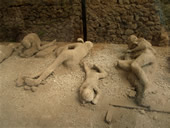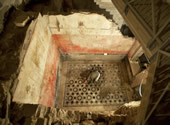- Pompei
The city of Pompeii was an ancient Roman town-city near modern Naples in the Italian region of Campania, in the territory of the comune of Pompei. Pompeii along with Herculaneum and many villas in the surrounding area, were mostly destroyed and buried under 4 to 6 m of ash and pumice in the eruption of Mount Vesuvius in 79 AD.
Researchers believe that the town was founded in the seventh or sixth century BC and was captured by the Romans in 80 BC. By the time of its destruction, 160 years later, its population was probably approximately 20,000, with a complex water system, an amphitheatre, gymnasium and a port.
The eruption was cataclysmic for the town. Evidence for the destruction originally came from a surviving letter by Pliny the Younger, who saw the eruption from a distance and described the death of his uncle Pliny the Elder, an admiral of the Roman fleet, who tried to rescue citizens. The site was lost for about 1500 years until its initial rediscovery in 1599 and broader rediscovery almost 150 years later by the Spanish engineer, Rocque Joaquin de Alcubierre in 1748. The objects that lay beneath the city have been well preserved for thousands of years because of the lack of air and moisture. These artifacts provide an extraordinarily detailed insight into the life of a city during the Pax Romana. During the excavation, plaster was used to fill in the voids between the ash layers that once held human bodies. This allowed one to see the exact position the person was in when they died.
Pompeii has been a tourist destination for over 250 years. Today it has UNESCO World Heritage Site status and is one of the most popular tourist attractions of Italy, with approximately 2.5 million visitors every year.
Gallery









